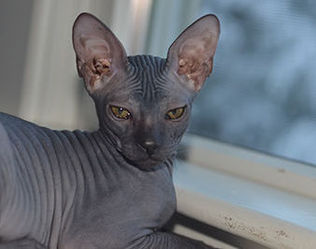History
The Donskoy is a Russian Breed of hairless cats also called the Don Sphynx. This breed was discovered in the city of Rostov-on-Don, Russia in 1987 by cat breeder Elena Kovaleva. She rescued a bald female kitten and called her Varvara. Elena treated this kitten medically for her baldness. This cat is the first truly hairless breed. A couple of years later, Varvara gave birth to kittens that also lost their hair just as their mother had. People thought the kittens were unhealthy and did not want them. Irina Nemikina, also a cat breeder, acquired one of these kittens from the litter and started a breeding program. In several years this new breed was named the Don Sphynx- Don after the river in Russia near where Varvara was found and Sphynx because they are hairless. It was later realized that this baldness was a result of a natural gene mutation. This breed was recognized by the World Cat Federation (WCF) in 1997 and by The International Cat Association (TICA) in 2005. In TICA it is known as the Donskoy.
About the Breed
The Donskoy cat is highly intelligent, friendly, loving and loyal to their owners. They are active, socially interested in their surroundings and enjoy playing alone with a ball or cat toy or chasing a feather ended cat stick you dangle in front of them! One of the greatest things about the Donskoy is that it blurs the traditional boundaries between cats and dogs. Dog lovers will adore this cat!. The Donskoy combines the best qualities of the dog and cat into one! They are trainable, come when called by name. Love to follow you around the house and sit and snuggle on your lap or in bed, yet are content to spend alone time and are undemanding.
A Donskoy is a strong boned, muscular, medium sized cat with soft wrinkled skin that is hot to the touch. There are four coat types and they come in all colors.All but one coat usually results in hairlessness. In the breed it is a dominant gene for hairlessness that causes their birth coat to fall out if they have one. The shedding occurs during the period from 2 months to 2 years of age. The Donskoy is unique in that it may also grow a winter coat (fine wool on the chest and hairs on the end of the tail) and will lose it when the weather warms.
The four types of Donskoy Coats:
Rubber Bald:
The Donskoy is born bald and remains bald throughout it’s life.
Flock Coat:
The Donskoy appears hairless, but has the texture of a soft chamois. The Flock coat can disappear and the cat can become bald.
Velour Coat:
Donskoy are born with a bald spot or Monk’s cap on the top of the head. Their wool-like coat becomes wiry and disappears gradually within the first year or so with some residual hair remaining on the face, legs and tail. Donskoy with the Velour coat can also completely lose their hair and become bald over time.
Brush Coat:
Only a portion of their coat is lost over time. Their coat can be bristly, wavy, and often wiry on their whole body with bald areas on the head, upper part of neck or back.
The cats body tends to be pear shaped with the back legs slightly longer than the front legs. Their skin is very elastic and wrinkly. Wrinkles are on the head, neck, belly, legs and tail. The ears sit high and are medium to large, wide open with a slight tilt forward and the tips of the ears being rounded. Eyes are almond shaped and slanted. They can appear to be squinting at times. Donskoy paws are very distinctive with long webbed toes and thumbs that bend inward which enable them to grab things. Their paws resemble monkey fingers. The tail is medium long and straight.
Males are larger than females. Altered males are usually 10-12 lbs, where as altered females are 6-8 lbs. Their life expectancy is 12+ years.


.jpg)





















